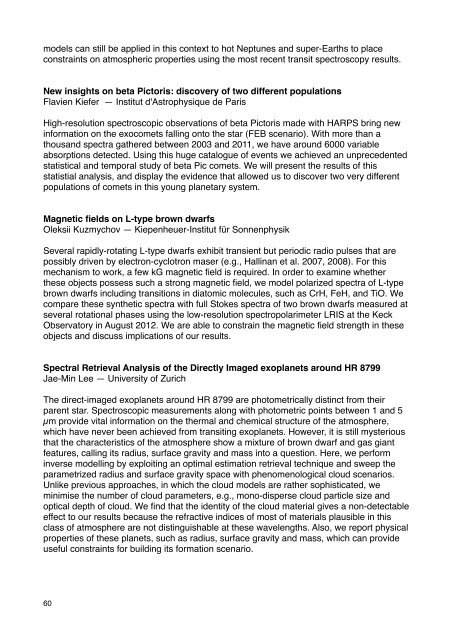Exoclimes_Conference_booklet1
Exoclimes_Conference_booklet1
Exoclimes_Conference_booklet1
Create successful ePaper yourself
Turn your PDF publications into a flip-book with our unique Google optimized e-Paper software.
models can still be applied in this context to hot Neptunes and super-Earths to place<br />
constraints on atmospheric properties using the most recent transit spectroscopy results.<br />
New insights on beta Pictoris: discovery of two different populations<br />
Flavien Kiefer — Institut d'Astrophysique de Paris!<br />
High-resolution spectroscopic observations of beta Pictoris made with HARPS bring new<br />
information on the exocomets falling onto the star (FEB scenario). With more than a<br />
thousand spectra gathered between 2003 and 2011, we have around 6000 variable<br />
absorptions detected. Using this huge catalogue of events we achieved an unprecedented<br />
statistical and temporal study of beta Pic comets. We will present the results of this<br />
statistial analysis, and display the evidence that allowed us to discover two very different<br />
populations of comets in this young planetary system.<br />
Magnetic fields on L-type brown dwarfs!<br />
Oleksii Kuzmychov — Kiepenheuer-Institut für Sonnenphysik<br />
Several rapidly-rotating L-type dwarfs exhibit transient but periodic radio pulses that are<br />
possibly driven by electron-cyclotron maser (e.g., Hallinan et al. 2007, 2008). For this<br />
mechanism to work, a few kG magnetic field is required. In order to examine whether<br />
these objects possess such a strong magnetic field, we model polarized spectra of L-type<br />
brown dwarfs including transitions in diatomic molecules, such as CrH, FeH, and TiO. We<br />
compare these synthetic spectra with full Stokes spectra of two brown dwarfs measured at<br />
several rotational phases using the low-resolution spectropolarimeter LRIS at the Keck<br />
Observatory in August 2012. We are able to constrain the magnetic field strength in these<br />
objects and discuss implications of our results.<br />
Spectral Retrieval Analysis of the Directly Imaged exoplanets around HR 8799<br />
Jae-Min Lee — University of Zurich<br />
The direct-imaged exoplanets around HR 8799 are photometrically distinct from their<br />
parent star. Spectroscopic measurements along with photometric points between 1 and 5<br />
µm provide vital information on the thermal and chemical structure of the atmosphere,<br />
which have never been achieved from transiting exoplanets. However, it is still mysterious<br />
that the characteristics of the atmosphere show a mixture of brown dwarf and gas giant<br />
features, calling its radius, surface gravity and mass into a question. Here, we perform<br />
inverse modelling by exploiting an optimal estimation retrieval technique and sweep the<br />
parametrized radius and surface gravity space with phenomenological cloud scenarios.<br />
Unlike previous approaches, in which the cloud models are rather sophisticated, we<br />
minimise the number of cloud parameters, e.g., mono-disperse cloud particle size and<br />
optical depth of cloud. We find that the identity of the cloud material gives a non-detectable<br />
effect to our results because the refractive indices of most of materials plausible in this<br />
class of atmosphere are not distinguishable at these wavelengths. Also, we report physical<br />
properties of these planets, such as radius, surface gravity and mass, which can provide<br />
useful constraints for building its formation scenario.<br />
60


